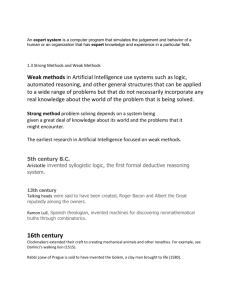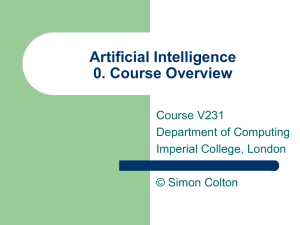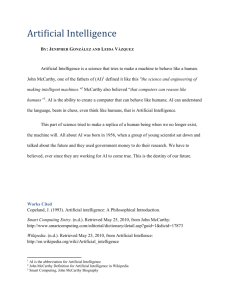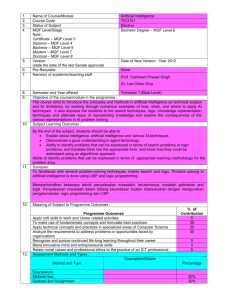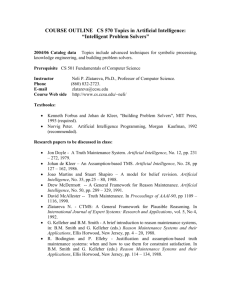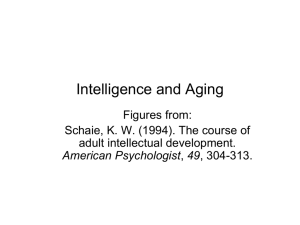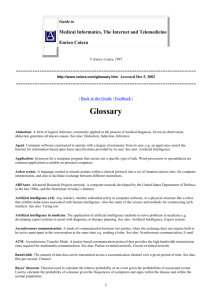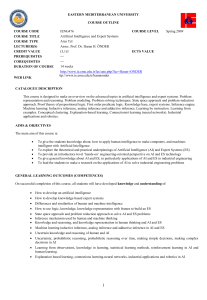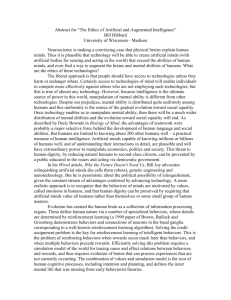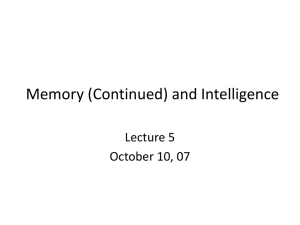Introduction to Artificial Intelligence
advertisement
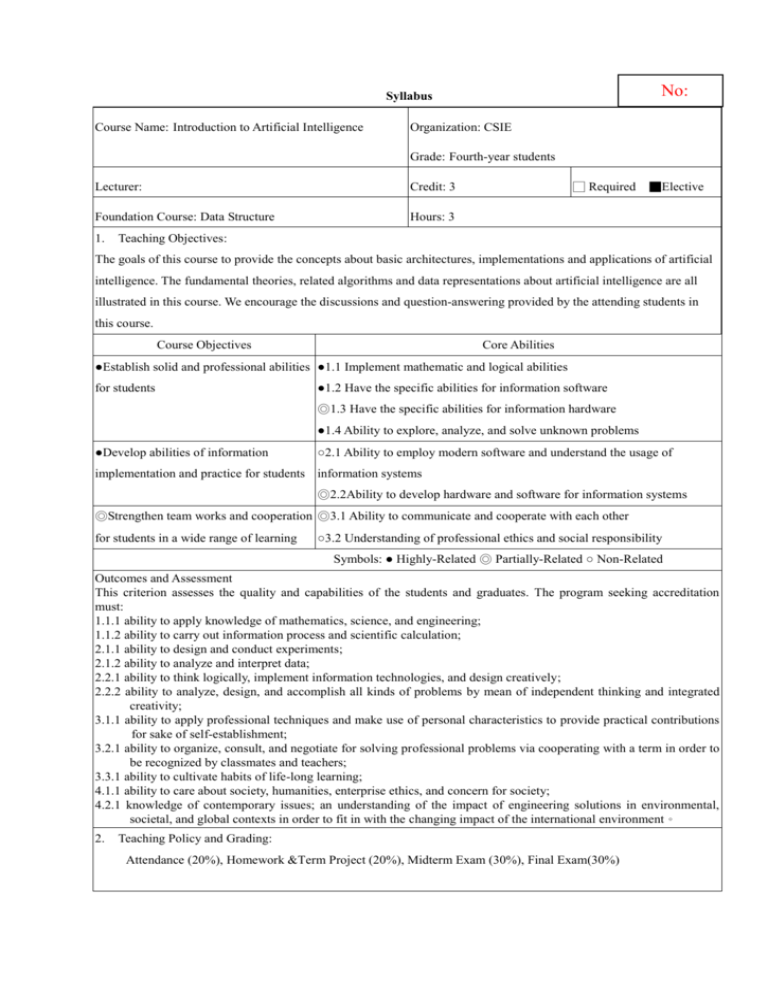
No: Syllabus Course Name: Introduction to Artificial Intelligence Organization: CSIE Grade: Fourth-year students Lecturer: Credit: 3 Foundation Course: Data Structure Hours: 3 1. □ Required ■Elective Teaching Objectives: The goals of this course to provide the concepts about basic architectures, implementations and applications of artificial intelligence. The fundamental theories, related algorithms and data representations about artificial intelligence are all illustrated in this course. We encourage the discussions and question-answering provided by the attending students in this course. Course Objectives Core Abilities ●Establish solid and professional abilities ●1.1 Implement mathematic and logical abilities for students ●1.2 Have the specific abilities for information software ◎1.3 Have the specific abilities for information hardware ●1.4 Ability to explore, analyze, and solve unknown problems ●Develop abilities of information ○2.1 Ability to employ modern software and understand the usage of implementation and practice for students information systems ◎2.2Ability to develop hardware and software for information systems ◎Strengthen team works and cooperation ◎3.1 Ability to communicate and cooperate with each other for students in a wide range of learning ○3.2 Understanding of professional ethics and social responsibility Symbols: ● Highly-Related ◎ Partially-Related ○ Non-Related Outcomes and Assessment This criterion assesses the quality and capabilities of the students and graduates. The program seeking accreditation must: 1.1.1 ability to apply knowledge of mathematics, science, and engineering; 1.1.2 ability to carry out information process and scientific calculation; 2.1.1 ability to design and conduct experiments; 2.1.2 ability to analyze and interpret data; 2.2.1 ability to think logically, implement information technologies, and design creatively; 2.2.2 ability to analyze, design, and accomplish all kinds of problems by mean of independent thinking and integrated creativity; 3.1.1 ability to apply professional techniques and make use of personal characteristics to provide practical contributions for sake of self-establishment; 3.2.1 ability to organize, consult, and negotiate for solving professional problems via cooperating with a term in order to be recognized by classmates and teachers; 3.3.1 ability to cultivate habits of life-long learning; 4.1.1 ability to care about society, humanities, enterprise ethics, and concern for society; 4.2.1 knowledge of contemporary issues; an understanding of the impact of engineering solutions in environmental, societal, and global contexts in order to fit in with the changing impact of the international environment。 2. Teaching Policy and Grading: Attendance (20%), Homework &Term Project (20%), Midterm Exam (30%), Final Exam(30%) Descriptions for the Course: Artificial Intelligence: A Modern Approach, Second Ed. (Prentice Hall) edited by Stuart Russell and Peter Norvig is used as the text book in this course. This book is one of the most popular text books for AI. Most of the course is teaching by the lecture, A team-work final project is necessary for all the students who attend this course. The goal of this project is to help students attending this course to understand the AI related algorithms and software development skills. After the implementation, a oral presentation is asked in the course. There are some discussions about system software especially for AI applications and implementations. 3. Contents and Progression: Outline Corresponding to Students’ Core Implementation Abilities Topics Introduction Contents 1.1 1.2 1.3 1.4 2.1 2.2 3.1 3.2 A 1. Introduction to this course ○ ◎ ◎ ◎ ○ ○ ○ ○ 2.Basic concepts about AI ◎ ◎ ◎ ● ○ ○ ○ ○ 3.Solving Problems by B C D ○ ● ○ ◎ ○ ○ ○ ○ Searching 4. First-Order Logic and ● ● ○ ◎ ○ ○ ○ ○ Inference Problem Solving Reasoning Basic Learning Theory Knowledge Representations Project 4. and 5.Rule-based Knowledge ● ● ○ ● ○ ○ ○ ○ Representation and Inference 6.Uncertainty ● ● ○ ● ○ ○ ○ ○ 7.Case-based Inference ● ● ○ ● ○ ○ ○ ○ 8.Fuzzy Inference ● ● ○ ● ○ ○ ○ ○ 9.Learning from Observations ◎ ● ○ ● ○ ○ ○ ○ 10.Clustering ● ● ○ ● ○ ○ ○ ○ 11.Association Rules ● ● ○ ● ○ ○ ○ ○ 12.Ontology ◎ ● ○ ● ○ ○ ○ ○ 13.Intelligent Agents ◎ ● ○ ● ○ ○ ○ ○ 14. Project Assignment ● ● ○ ● ● ◎ ● ○ 15. Oral presentations ● ● ○ ● ○ ◎ ● ○ References: 1. Stuart Russell and Peter Norvig, Artificial Intelligence: A Modern Approach, Second Ed., Prentice Hall, 2003. 2. Joseph Giarratano and Gary Riley, Expert Systems Principles and Programming, Third Ed., PWS Publishing Co., 1998. 3. Michael Negnevitsky, Artificial Intelligence: A Guide to Intelligent Systems, Second Ed., Addison Wesley, 2004. 4. Ben Coppin, Artificial Intelligence illuminated. Jones and Bartlett Publishers.


